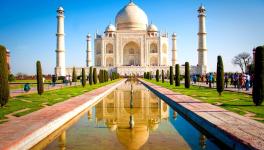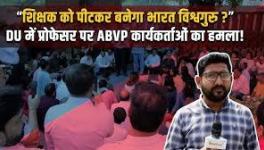Why Religious Processions are Like Soldiers Marching Across Foreign Lands
Religious processions pair binaries to trigger conflicts between Hindus and Muslims. These binaries include domination and resistance, conquest and subjugation, sacred and profane and such like. The pairing builds upon a long history, and memory, of harnessing religious processions as a tool for political mobilisation, a scintillating account of which is provided by political scientist Christophe Jaffrelot in his essay, ‘The politics of processions and Hindu-Muslim riots.’
The phenomenon of religious processions culminating in violence is more than a century old, and repetitive in its performance. But the recent violence on Ram Navami and Hanuman Jayanti has injected two new elements into religious processions—the state’s post-violence role; and the use of mass media, particularly TV channels and social media, to further deepen the binaries outlined above.
Religious processions are much like columns of soldiers marching through a foreign territory. Opposition to the march creates a context and pretext for retaliation, mimicking, for instance, America’s invasion of Iraq in 2003 and Russia’s of Ukraine. Just as these types of invasion polarise the world, so do religious processions segregate the people of India into two opposing camps, engaged in incessant verbal duels.
Obviously, no area in India can be labelled as foreign or deemed out of bounds for processions, whether Hindu or Muslim. It is considered a religious community’s right to have its processions wend through any area in a city, subject to the approval of the authorities. Opposition to such processions becomes an infraction of that right.
History and memory have helped create this right and what constitutes its infraction. One reason for processions turning violent is because of their exclusivist nature. Many decades earlier, Hindu groups participated in Muharram processions and Muslim musicians would perform at certain Hindu festivals. The inter-community participation worked as a natural check on processions turning into communal conflagrations.
Backstory of Processions
The twist came in 1896, when Bal Gangadhar Tilak’s Kesari newspaper noted, “Why should we not be able to convert large religious festivals into political rallies?” Tilak asked Hindus not to participate in the Muharram processions of Muslims, and then brought out the Ganesh Chaturthi festival, celebrated to mark the arrival of Ganesh on earth, from the private to the public sphere.
Tilak’s idea was to utilise the Ganesh festival to mobilise and unite Hindus, with the aim of incorporating into Hinduism, as Jaffrelot points out, a “practice he [Tilak] perceived as a strength of Islam—assembly [or congregation] and worship as a community of equals.” With lower castes barred from entering temples, religious processions became an occasion to transcend the caste-class divide.
This was to be achieved through a show of masculinity and militancy. Thus, the Ganesh procession saw young Hindu men donning the uniform of Shivaji’s soldiers, and chanting militant slogans marking the immersion of the Ganesh idol. The reimagined exclusivist Ganesh festival and procession, the British administration knew, could become a recipe for rioting if it were to pass through Muslim-dominated areas. The administration took to deciding the route the Ganesh Chaturthi procession should or should not take.
In 1894, in Poona (now Pune), Tilak’s followers had already defied the District Magistrate’s order and taken their procession past a mosque, triggering a riot. They did the same next year. But this time, Muslims had stockpiled weapons. A bloody riot followed.
A new template for rioting was created, marked by, as Jaffrelot writes, three features—the sense of Hindu vulnerability to the violence Muslims were accused of initiating; using processions to build Hindu solidarity; and insistence on a particular route to take out a procession. The last often meant processions would pass through Muslim areas, peppered with mosques.
Religious processions sparking riots became more frequent and bloodier during the Khilafat movement (1919-1924), as was the case in Calcutta (now Kolkata) in 1924 and 1926. Although there were many causes behind India bleeding periodically—the slaughter of the cow, for instance—religious processions enacted, rather dramatically, the provocation-reaction model, gradually evolving into a veritable call to battle.
Consider this: Hindu processionists would insist to pass through a Muslim area; it would be known in advance that music would be played before mosques. Muslims sentiments would be expected to get hurt, because of which the authorities were often inclined to banning them. A priori determination implied that if processionists behaved as was feared and Muslims did not retaliate, they would have tacitly accepted their defeat or subjugation.
The Ashvamedha Theory
To fathom this psychology, think of the Ashvamedha ceremony of ancient India. The territory across which the king’s horse, after being set loose, would traverse without being challenged or captured was deemed to belong to him.
Likewise, religious processions are designed to bring into play the dynamics of domination and resistance, conquest and subjugation. Whoever wants to be defeated and subordinated? This is more so as processionists refuse to honour the sacredness of mosques. For them, these holy places are sites for engaging in profanity, evident from their playing music, chanting derogatory slogans and raising saffron flags from the domes of mosques.
This psychology is palpable from the example of Nagpur that Jaffrelot cites in his essay. In 1923, the city’s small Muslim population complained that Hindu processions, accompanied with blaring music, were often being taken past mosques. On 30 October 1923, the administration banned all processions.
In response, Hindu Mahasabha leader BS Moonje rallied 20,000 Hindus to protest against the ban. “Having proved his point, in November, he [Moonje] organised a procession which involved music and passed several mosques. Since both camps had been armed beforehand, the subsequent riot entailed heavy casualties,” Jaffrelot writes.
The binaries of invasion and conquest, assertion and subjugation, sacred and profane continued to be the features of Hindu religious processions even in post-Independence India. The goal now was of uniting Hindus across the caste divide to challenge the hegemony of the Congress. The list of riots sparked by religious processions can be accessed (here and here ) from the data of the Paris Institute of Political Science, popularly known as Sciences Po.
In many of these riots, the RSS and its affiliates played a principal role. The experience gained from a long chain of riots proved useful for the RSS and the Bharatiya Janata Party to mobilise Hindus during the Ram Janmabhoomi movement, during which processions, with participants lustily chanting anti-Muslim slogans, seemed like an army marching out to conquer a foreign land, as seen in those period films.
Processions after 2014
It may seem outdated to insist on Hindu religious processions passing through Muslim areas in this era of Hindutva ascendency. After all, the minority community, over the last eight years, has been constantly battered, bruised and demonised. That the Hindutva brigade should continue to organise processions to mobilise Hindus testifies to the harsh truth that it still needs to consolidate Hindus to win elections. The economic slowdown, in fact, has made belligerent processions almost a necessity for the BJP.
Its task is facilitated by the 24x7 focus of TV channels on the violence sparked by religious processions. Skirmishes in Madhya Pradesh or Gujarat become talking points countrywide. For instance, how many knew of Jahangirpuri, a working class quarters in Delhi, until a fortnight ago?
But there are also psychological and ideological dimensions to the RSS persisting with religious processions. Hindutva cannot claim victory as long as Muslims resist or fight back against processionists shouting slogans abusive of them and their religion. Their resistance is a symbol that they have not been subjugated. This is why bulldozers were rolled in to demolish shops and houses in those areas where Ram Navami and Hanuman Jayanti processions were allegedly stoned by Muslims.
This punitive action, dressed up as a drive against encroachment, is to tell Muslims that their resistance will invite State retribution, a message, once again, transmitted across India through TV channels and social media. This message is designed for Muslims inclined to resist Hindutva in the future: Accept provocations, insults, perhaps even desecration, or endure punishment and impoverishment.
Indeed, no victory is complete unless the vanquished accept defeat and their subjugation. No victory is final as long as the conqueror is resisted. Just as Hindutva, despite setbacks, has pursued its mission of building a Hindu rashtra, there are many out there, Hindus and Muslims alike, who are unlikely to give up on the idea of a multicultural India. And so, India is doomed to bleed.
The author is an independent journalist. The views are personal.
Get the latest reports & analysis with people's perspective on Protests, movements & deep analytical videos, discussions of the current affairs in your Telegram app. Subscribe to NewsClick's Telegram channel & get Real-Time updates on stories, as they get published on our website.
























